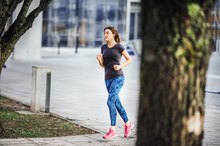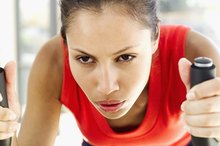What Happens to the Intercostal Muscles in Exercise?
Exercise elicits a number of physiological responses. A rapid and sustained increase in your breathing rate is just one of these reactions. The intercostal muscles aid in the increase in respiration with exercise. Without these muscles, your lungs would not be able to increase the air flow needed for physical activity.
In Your Body
The intercostal muscles come in two different types; both are located around the ribcage. The internal intercostal muscles are located on the inside of the ribcage. These muscle extend from the attachment of the ribs to the sternum and follow the ribs around to your back. The external intercostal muscles lie on the outside of the ribcage and extend from the back of the ribcage to the front.
- The intercostal muscles come in two different types; both are located around the ribcage.
- The external intercostal muscles lie on the outside of the ribcage and extend from the back of the ribcage to the front.
When Not Exercising
What Muscles Are Used When Coughing?
Learn More
Inhalation and exhalation is the result of the change of volume in the thorax. When you inhale, the diaphragm and external intercostals contract and lower the thorax, expanding the lungs. This causes the pressure inside the lungs to decrease, facilitating the flow of air into the lungs. Upon exhalation, the external intercostal muscles relax, allowing the thorax to return to its original position, forcing the air out.
- Inhalation and exhalation is the result of the change of volume in the thorax.
- Upon exhalation, the external intercostal muscles relax, allowing the thorax to return to its original position, forcing the air out.
During Exercise
During exercise, your respiratory rate increases, which is facilitated by the intercostal muscles. As during rest, the external intercostal muscles work to pull air into the lungs. When you are exercising, though, the act of exhaling becomes an active movement. The intercostal muscles work to force air out of your lungs by moving the ribcage down and in, thus forcing air out.
- During exercise, your respiratory rate increases, which is facilitated by the intercostal muscles.
- As during rest, the external intercostal muscles work to pull air into the lungs.
Changes in Respiration With Exercise
What Happens to Your Lungs When You Exercise?
Learn More
The intercostal muscles make the movement of more air into and out of your lungs achievable during exercise. During rest, your lungs move about 6 liters of air per minute, but during exercise this amount can increase to 192 liters per minute, in a fit, healthy person. More than that, the frequency of breathing at rest is about 12 breaths per minute, but during exercise, your intercostal muscles make it possible to increase to 48 breaths per minute.
Related Articles
References
- Exercise Physiology; George A. Brooks, Thomas D. Fahey, Kenneth M. Baldwin
- Voice and Speech Source: Intercostal Muscles
- Physiological Reviews: Respiratory Action Of The Intercostal Muscles
- International Pain Foundation. What is intercostal neuralgia?
- MedlinePlus. When to use the emergency room—adult. Updated August 4, 2018.
- Tirlapur SA, Priest L, Daniels JP, et al. How do we define the term idiopathic? Curr Opin Obstet Gynecol. 2013;25(6):468–473. doi:10.1097/GCO.0000000000000025
- Dureja GP. Intercostal neuralgia: A review. J Neurol Transl Neurosci. 2017; 5(1): 1076.
- Thomas S., Lopez F. Intercostal pain syndromes. In: Kahn S., Xu R. (eds) Musculoskeletal Sports and Spine Disorders. 2017.
- Winzenberg T, Jones, G, Callisaya, M. Musculoskeletal chest wall pain. Thorax. 2015;44(8): 540-544
- American Heart Association. Exercise stress test. Updated July 31, 2015.
- Abd-Elsayed A, Lee S, Jackson M. Radiofrequency ablation for treating resistant intercostal neuralgia. Ochsner J. 2018;18(1):91–93.
Writer Bio
Laura Niedziocha began her writing career in 2007. She has contributed material to the Stoneking Physical Therapy and Wellness Center in Lambertville, N.J., and her work has appeared in various online publications. Niedziocha graduated from Temple University with a Bachelor of Science in exercise science. She also has her Associate of Arts in communications from the Community College of Philadelphia.









